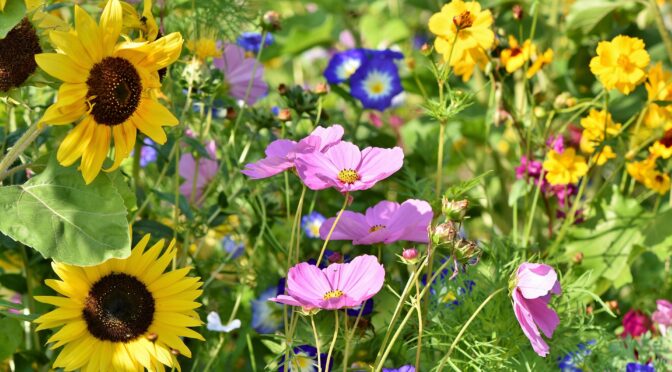If you spend time browsing gardening sites or scrolling TikTok and Instagram, you may have noticed a trend: chaos gardening. This gardening style is touted as easy, affordable, and environmentally friendly, and all you need to do is toss some seeds. What’s not to love? In today’s post, we’ll explore chaos gardening, its pros and cons, and how to practice it in your garden.
What is Chaos Gardening?
Chaos gardening is a carefree style in which the gardener randomly throws seeds over their selected space. You can use flowers, vegetables, herbs, or perennials and mix them together. There’s no planning a layout or careful seed sowing; just give them a fling!
The idea of chaos gardening is to ditch the idea that lawns and gardens must be highly organized and maintained. You can create a beautiful, full-looking garden without a lot of work or amendments.
Obviously, in this gardening style, some plants do much better than others. Proponents of this garden style enjoy the surprise and thrill of what thrives rather than planning for certain crops. This also means that they don’t use a lot of resources, like water, in dry parts of the country to keep plants alive that just aren’t thriving.
 Does Chaos Gardening Work?
Does Chaos Gardening Work?
Yes, chaos gardening does work, but as we mentioned above, some plants will do much better in this style than others. If your goal is large heads of broccoli or killer slicing tomatoes for sandwiches, this may not be the right style for you. Maybe you can try it in one bed or section.
Here are some of the great things about chaos gardening as well as some of the issues with it:
Benefits
- It can take the stress out of garden planning and layout.
- It can be a great way to support pollinators.
- You can use up old seeds.
- These gardens don’t require maintenance.
- It may help with pest issues.
- You can rewild part of your lawn.
- You can use this style to create pollinator strips within a vegetable garden.
Issues
- It is less productive for certain crops, particularly vegetables.
- You may still feel the need to weed, and it can be challenging to distinguish plants.
- You still need to do solid soil prep work.
Generally speaking, chaos gardening works, but you need to be okay with less production and a garden that tends more toward a wildflower meadow than a vegetable patch.
How to Chaos Garden
While chaos gardening is usually advertised as less work, it’s important to remember that there’s still plenty of work to be done outside of sowing to ensure your plants thrive. Work begins with the soil.
Choose an area that gets plenty of sun unless you’re working with shade-tolerant seeds. Then, you’ll need to prepare a bed and keep it free of weeds and grass. I always like to add a couple of inches of finished compost.
Once your soil is prepared, you can begin sowing your seeds. Chaos is the name of the game here, so give them a toss!
If you have a lot of larger seeds, like cucumber or bean seeds, for best results, I recommend sowing them first and then scattering some compost over top of them. Then, you can move on to the finer seeds, like poppies and dill.
After you sow all of your seeds, you should walk on them to press them into the soil. This will help them stay moist and improve your germination rate. For best results, water them in and then keep a consistent watering schedule, at least until all of your plants are established.

What Seeds Should I Use?
Native species and wildflowers for pollinators are good choices because they generally perform well in this gardening style and have ecological benefits. Don’t let that limit you, though. You can try chaos gardening with any seeds you have on hand. Of course, some seeds will perform better than others.
Chaos gardening can also be a helpful way to use up extra seeds or seeds that are years old and have less-than-ideal germination rates.
Note that aggressive spreaders and invasive varieties should be avoided. Before seeding, consider what’s appropriate for your areas.
If you want to purchase seeds for a chaos garden, here are some crops that chaos gardeners like to use and a few we think are well-suited to this style:
- Rudbeckia
- Echinacea
- Bachelor’s Buttons
- Cleome
- Calendula
- Sweet Alyssum
- Cosmos
- Bee Balm
- Phlox
- Carrots
- Looseleaf Lettuce
- Matt’s Wild Cherry Tomatoes
- Everglades Tomatoes
- Peruviana Red or Peruviana Yellow Zinnias
- Long Island Mammoth Dill
- Bread Seed Poppies
- Sunflowers
- Cucumbers
- Chamomile
- Amaranth
- Cilantro
- Creasy Greens (Upland Cress)
- Fennel
- Hyssop
- Parsley
- Yarrow
These all tend to be sturdy, easy-to-grow crops that tolerate a bit of crowding and weed pressure.
Do I Need to Tend My Chaos Garden?
After seeding, how much work you put into your chaos garden is up to you. Some growers try to pick out any weeds or do a bit of thinning, while others are entirely hands-off. One of the great things about this style is that you will probably still get some flowers and other crops even if you don’t have time for a traditional garden.
Chaos gardening can be a fun way to use up old seeds, rewild parts of your lawn, support pollinators, and grow a mix of crops. We’re not saying you should give up on your traditional garden, but if you’ve got some lawn to get rid of or a little space you can’t decide what to do with, give chaos gardening a try!

